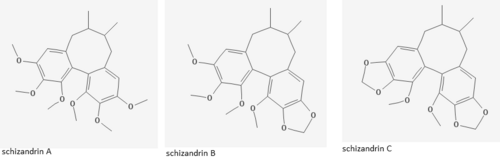Biology:Schisandrin
Schisandrins [1] (schizandrins) are a group of bioactive chemical compounds found in Schisandra rubriflora, Schisandra sphenanthera, and Schisandra chinensis.[2][3] Schizandrin is a tannin.[4]

IUPAC Name*
3,4,5,14,15,16-hexamethoxy-9,10-dimethyltricyclo[10.4.0.02,7]hexadeca-1(16),2,4,6,12,14-hexaen-9-ol *Computed by Lexichem TK 2.7.0 (PubChem release 2021.05.07)
CAS Common Chemistry[6][7][8]
7432-28-2
Molecular Formula
[math]\ce{ C24H32O7 }[/math]
Molecular Weight
432.5
PubChem CID
23915[9]
Characteristics
Schisandra chinensis (S. chinensis) berries, originally a component of traditional herbal medicine in China, Korea, and other east Asian countries, are also valuable agents in modern phototherapy. S. chinensis berry preparations, including extracts and their chemical components, demonstrate anti-cancer, hepatoprotective, anti-inflammatory, and antioxidant properties, among others. These valuable properties, and their therapeutic potential, are conditioned by the unique chemical composition of S. chinensis berries, particularly their lignan content. About 40 of these compounds, mainly dibenzocyclooctane type, were isolated from S. chinensis. The most important bioactive lignans are schisandrin (also denoted as schizandrin or schisandrol A), schisandrin B, schisantherin A, schisantherin B, schisanhenol, deoxyschisandrin, and gomisin A. The present work reviews newly-available literature concerning the cardioprotective potential of S. chinensis berries and their individual components. It places special emphasis on the cardioprotective properties of the selected lignans related to their antioxidant and anti-inflammatory characteristis.[10]
Examples include:
- Schisandrin A
- Schisandrin B (γ-schisandrin)
- Schisandrin C
References
- ↑ "WikiData". https://www.wikidata.org/wiki/Q99542848.
- ↑ Park, SY; Park, SJ; Park, TG; Rajasekar, S; Lee, SJ; Choi, YW (2013). "Schizandrin C exerts anti-neuroinflammatory effects by upregulating phase II detoxifying/antioxidant enzymes in microglia". International Immunopharmacology 17 (2): 415–26. doi:10.1016/j.intimp.2013.06.032. PMID 23859871.
- ↑ "LOTUS - the natural products occurrence database". https://pubchem.ncbi.nlm.nih.gov/source/LOTUS%20-%20the%20natural%20products%20occurrence%20database.
- ↑ "Chemical Entities of Biological Interest (ChEBI)". https://www.ebi.ac.uk/chebi/searchId.do?chebiId=CHEBI:80900.
- ↑ "PubChem \ United States National Library of Medicine". https://pubchem.ncbi.nlm.nih.gov/compound/23915#section=Names-and-Identifiers.
- ↑ "CAS Common Chemistry". https://commonchemistry.cas.org/detail?cas_rn=7432-28-2.
- ↑ "EPA DSSTox". https://comptox.epa.gov/dashboard/DTXSID20995843.
- ↑ "European Chemicals Agency (ECHA)". https://echa.europa.eu/information-on-chemicals.
- ↑ "PubChem CID \ United States National Library of Medicine". https://pubchem.ncbi.nlm.nih.gov/compound/23915.
- ↑ ""Cardioprotective Potential of Berries of Schisandra chinensis Turcz. (Baill.), Their Components and Food Products" Beata Olas \ United States National Library of Medicine". https://pubmed.ncbi.nlm.nih.gov/36771299/.
 |


